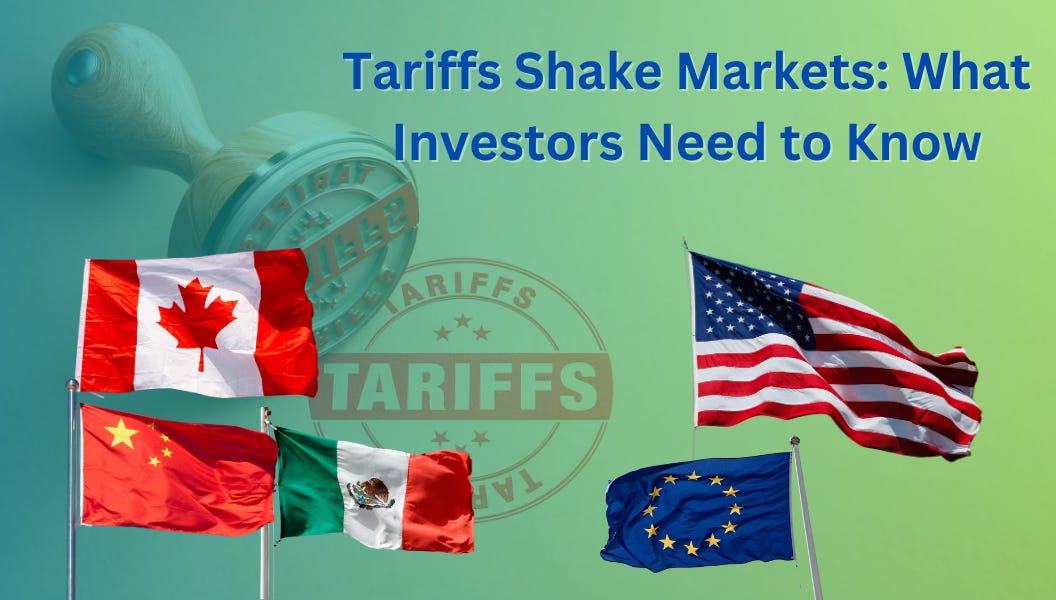Tariffs Shake Markets: What Investors Need to Know
Trade Policy in Flux: A Volatile Landscape
The global trade environment remains highly uncertain as the Trump administration continues to shift its stance on tariffs. Most notably, Trump has paused the planned 25% tariffs on Canada and Mexico for at least 30 days following agreements with leaders of both nations. Mexico has committed to reinforcing its northern border with 10,000 troops, while Canada will deploy additional personnel to the U.S. southern border and appoint a "fentanyl czar." However, Trump has conditioned the suspension on a final economic deal with Canada, and there is still a risk that these tariffs could be reinstated. Meanwhile, new tariffs on the European Union, pharmaceuticals, semiconductors, and industrial metals remain on the table, adding to global market volatility.
China Tariffs and Retaliation: A Cautious Response
Trade tensions between the U.S. and China remain unresolved, with Trump and President Xi failing to speak as expected. Although a call may still occur, Trump has downplayed its urgency. In response to the U.S.'s latest 10% tariff hike on Chinese goods, Beijing imposed a 15% tariff on LNG and coal, along with a 10% tariff on oil and farm machinery. However, China's countermeasures were relatively restrained, covering only about $14 billion in imports and excluding American agricultural products—suggesting Beijing remains open to negotiations. Additionally, Chinese regulators have revived antitrust investigations into Nvidia (NVDA), Alphabet (GOOGL), and are considering a probe into Intel (INTC), potentially escalating tensions.
Legislative Gridlock and Economic Uncertainty
While tariffs dominate market concerns, broader policy uncertainty under Trump 2.0 extends to tax policy, government spending, and legislative divisions. Republican infighting over a large reconciliation bill has led to competing approaches in the House and Senate. Disagreements over the extension of Trump-era tax cuts and new tax proposals have created uncertainty, with discussions now shifting toward a shorter-term, five-year package rather than permanent cuts. Additionally, Trump's funding freeze efforts are raising fears of a government shutdown next month, adding another layer of risk for markets.
Big Tech in the Crosshairs: EU and China Retaliate
Technology companies remain a key target in the escalating trade war. The European Union is preparing retaliatory measures against U.S. tech firms if Trump follows through with his tariff threats, potentially restricting software and streaming services. Meanwhile, China may increase regulatory pressure on Apple (AAPL), with antitrust authorities reportedly scrutinizing App Store policies—including its 30% fee structure and restrictions on external payment services. The U.S. has also temporarily barred inbound packages from China and Hong Kong, which could impact Chinese e-commerce giants like Shein and PDD’s Temu. These moves follow reports that Beijing is targeting Nvidia, Google, and possibly Intel as part of its response to Trump's tariffs.
Key Takeaways for Investors
The evolving trade landscape presents a volatile mix of risks and opportunities. While Trump’s pause on Canada and Mexico tariffs offers temporary relief, the situation remains fluid. China’s response, though measured, signals potential for further escalation, particularly if new tariffs are imposed. Meanwhile, policy uncertainty in Washington — ranging from tax extensions to spending battles —adds to market unpredictability.
Investors should closely monitor upcoming trade negotiations, government funding decisions, and regulatory actions targeting major U.S. tech firms. In this rapidly shifting environment, flexibility and vigilance will be key to navigating market turbulence.
At Triple Gains, we’ll keep tracking these evolving trade dynamics and their impact on market volatility. Stay tuned for deeper insights on how investors can navigate the risks and opportunities ahead.





